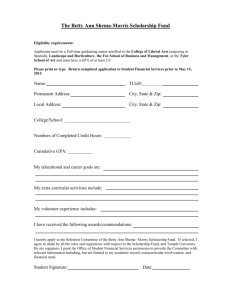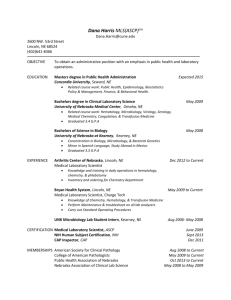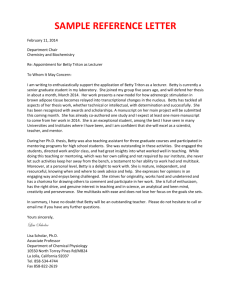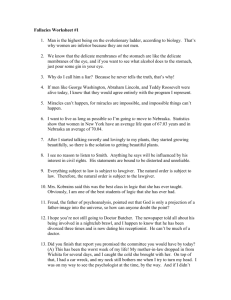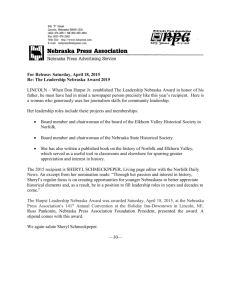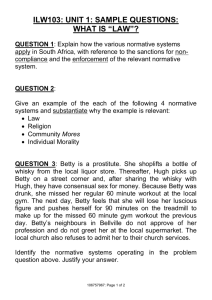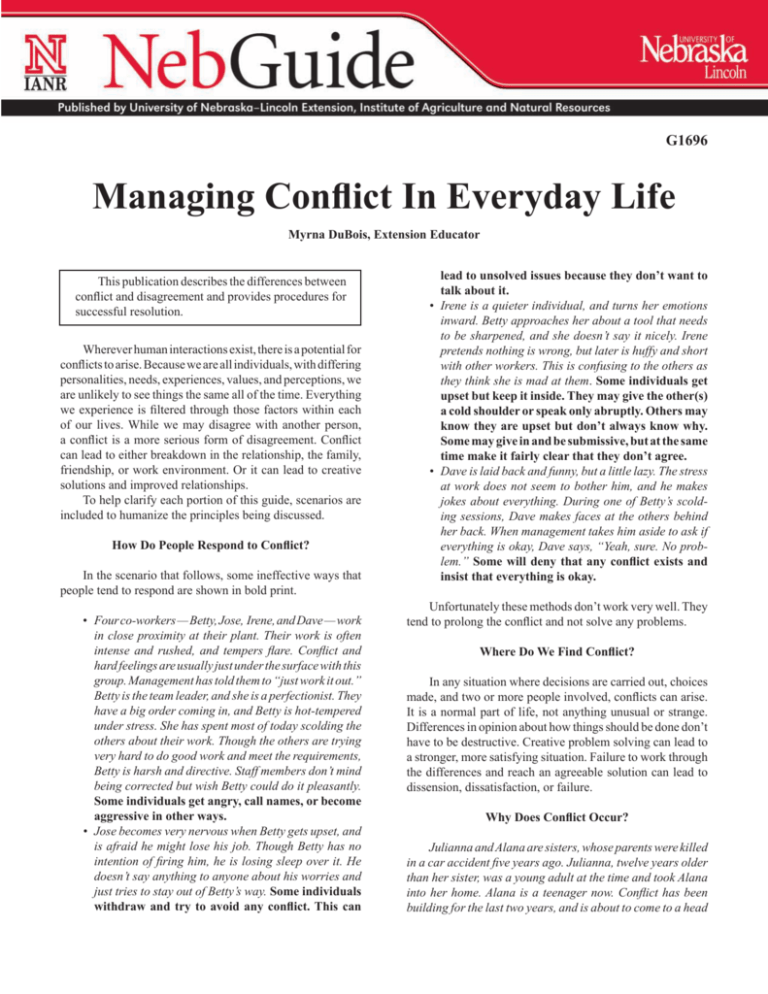
G1696
Managing Conflict In Everyday Life
Myrna DuBois, Extension Educator
This publication describes the differences between
conflict and disagreement and provides procedures for
successful resolution.
Wherever human interactions exist, there is a potential for
conflicts to arise. Because we are all individuals, with differing
personalities, needs, experiences, values, and perceptions, we
are unlikely to see things the same all of the time. Everything
we experience is filtered through those factors within each
of our lives. While we may disagree with another person,
a conflict is a more serious form of disagreement. Conflict
can lead to either breakdown in the relationship, the family,
friendship, or work environment. Or it can lead to creative
solutions and improved relationships.
To help clarify each portion of this guide, scenarios are
included to humanize the principles being discussed.
How Do People Respond to Conflict?
In the scenario that follows, some ineffective ways that
people tend to respond are shown in bold print.
• Four co-workers — Betty, Jose, Irene, and Dave — work
in close proximity at their plant. Their work is often
intense and rushed, and tempers flare. Conflict and
hard feelings are usually just under the surface with this
group. Management has told them to “just work it out.”
Betty is the team leader, and she is a perfectionist. They
have a big order coming in, and Betty is hot-tempered
under stress. She has spent most of today scolding the
others about their work. Though the others are trying
very hard to do good work and meet the requirements,
Betty is harsh and directive. Staff members don’t mind
being corrected but wish Betty could do it pleasantly.
Some individuals get angry, call names, or become
aggressive in other ways.
• Jose becomes very nervous when Betty gets upset, and
is afraid he might lose his job. Though Betty has no
intention of firing him, he is losing sleep over it. He
doesn’t say anything to anyone about his worries and
just tries to stay out of Betty’s way. Some individuals
withdraw and try to avoid any conflict. This can
lead to unsolved issues because they don’t want to
talk about it.
• Irene is a quieter individual, and turns her emotions
inward. Betty approaches her about a tool that needs
to be sharpened, and she doesn’t say it nicely. Irene
pretends nothing is wrong, but later is huffy and short
with other workers. This is confusing to the others as
they think she is mad at them. Some individuals get
upset but keep it inside. They may give the other(s)
a cold shoulder or speak only abruptly. Others may
know they are upset but don’t always know why.
Some may give in and be submissive, but at the same
time make it fairly clear that they don’t agree.
• Dave is laid back and funny, but a little lazy. The stress
at work does not seem to bother him, and he makes
jokes about everything. During one of Betty’s scolding sessions, Dave makes faces at the others behind
her back. When management takes him aside to ask if
everything is okay, Dave says, “Yeah, sure. No problem.” Some will deny that any conflict exists and
insist that everything is okay.
Unfortunately these methods don’t work very well. They
tend to prolong the conflict and not solve any problems.
Where Do We Find Conflict?
In any situation where decisions are carried out, choices
made, and two or more people involved, conflicts can arise.
It is a normal part of life, not anything unusual or strange.
Differences in opinion about how things should be done don’t
have to be destructive. Creative problem solving can lead to
a stronger, more satisfying situation. Failure to work through
the differences and reach an agreeable solution can lead to
dissension, dissatisfaction, or failure.
Why Does Conflict Occur?
Julianna and Alana are sisters, whose parents were killed
in a car accident five years ago. Julianna, twelve years older
than her sister, was a young adult at the time and took Alana
into her home. Alana is a teenager now. Conflict has been
building for the last two years, and is about to come to a head
over curfews, dating, and more. Alana frequently reminds
Julianna that she’s not her mother, and Julianna is frustrated
about how to help Alana be more responsible and safe.
Lack of communication is a common problem that can
lead to large levels of conflict. Sometimes we make assumptions about what the other person thinks or feels, without
actually talking to them about it. When we make assumptions,
the conclusions we reach can be much more negative than
actual fact. Because of her worries and their lack of communication, Julianna may be assuming the worst. Alana may
be more responsible than her sister realizes. It would also be
helpful if Alana would communicate her experiences rather
than lashing out at her older sister.
Lack of leadership occurs in many situations, whether
in the family or on the job. Questioning who’s in charge is
not unusual, and may occur when someone fails to take the
leadership role to which he or she has been assigned. Effective
leadership involves positive interactions with others, not just
giving out orders, and not taking a back seat when rules need
to be enforced. Because Julianna was young when she took on
the role of mother to her sister, she may not have realized the
importance of letting Alana know that she was in charge.
Lack of role division. If two people see each other’s roles
differently, expectations can lead to high levels of conflict.
Though Alana appears to be resisting Julianna’s rules, at the
same time she can feel at loose ends because she needs adult
approval and supervision.
Value conflicts. Sometimes our inner belief systems vary
so much from another person’s that it is difficult to reach a
conclusion satisfactory to both. It is like jumping on a horse
and riding off in all directions. We may not be able to follow
each person’s most valued concepts. An inner belief system is
sometimes called a paradigm. Paradigm shifts are extremely
difficult and create much inner conflict. This may or may not
apply to the sisters in the scenerio.
Resistance to change. Without a catalyst, our comfort
level is often at the “leave things as they are” stage. Change
is hard. Julianna may be resisting having her little sister grow
up, which is a common situation in a family.
What About Inner Conflict?
Though this guide focuses on conflict between individuals, it’s necessary to also mention inner conflict. Inner
conflict may occur at decision-making time, when two or
more alternatives seem viable. It may also occur when what
we are doing or are considering is contrary to our own value
system. Inner conflict is, without doubt, something that causes
discomfort. If inner conflict isn’t dealt with, or problems are
not solved satisfactorily, discouragement or even serious
depression can result.
A person can be so torn when trying to deal with a difficult situation that they find it hard to think clearly or to keep
on task. Dealing with inner conflict requires a lot of inner
thought processing. It may also require communicating with
another individual who has experienced similar situations or
who understands your value system.
How The Past Can Affect Conflict
In the early years of their marriage, Marie and David
went through some challenges, including differences of opinion
about money. Also, David felt that Marie’s mother interfered
in their relationship too much, and Marie felt David spent
too much time with guy friends. That was all ten years ago.
They are still together and doing much better. But when a
disagreement arises, the hurt feelings of the past always
seem to come up.
As humans, we tend to hold on to old grudges. We can
carry the baggage of old hurts around with us for years, and
the problems of the past can destroy any current happiness.
We can continue to carry baggage if the issues were
never dealt with at the time. Sometimes all a person needs to
drop past hurts is an acknowledgment from others that what
happened was hurtful. Since those acknowledgments aren’t
always forthcoming, it’s often necessary to work this through
by one’s self.
Forgiveness is one way to deal with focusing on the past.
Forgiving the other person for any wrongs, real or perceived,
not only helps mend the relationship, but takes a huge load
off our own chest.
Another method is to stick with the subject. We could
call failure to do this “dumping it over the fence.” If a couple
disagrees about disciplining children and suddenly the topic
turns to something said years ago, then we are dumping it over
the fence. Leave the past in the past. Focus on the issues at
hand and deal with them fully and fairly.
How Can Conflicts Best Be Managed?
Choose Your Battles Carefully
Jennifer, age 12, wears her hair in a ponytail a lot of
the time. Her mother wants her to do her hair differently. It’s
creating friction between Jennifer and her mother.
First of all, consider what you hope the outcome would
be for discussing the conflict you are concerned about. Is
the issue important enough to work on, to spend the time
on, or to even risk further damage to the relationship? Like
two children fighting over a half stick of gum, as adults we
sometimes become “bent out of shape” over issues not major
enough to justify the conflict created.
While parental guidance is extremely important to helping young people become productive and healthy adults, we
need to decide which issues are really important and need to
be resolved, and which ones, such as the ponytail issue above,
may not be worth disrupting family harmony.
Remain Calm
We cannot solve problems when we are angry. Conflicts can
only be managed when both or all participants are calm enough
to discuss the issues reasonably. Anger only makes things worse.
The good news is we can learn to manage our anger.
If you find yourself becoming angry, it is best to take
a step back, both physically and emotionally. Actually step
back from the person and put a little space between you. This
in itself can help you to start to feel more calm. Take a deep
breath. Count to 10.
If you’re still experiencing the physical energy that anger
creates, say “I am too upset to talk about this right now, I need
to cool down.” Then go do something to use up the energy.
Walk, run, punch a pillow. Don’t use this as an excuse to rid
yourself of the issue, but do go back and continue the discussion after you are calm.
Listen, Listen, Listen
Ruth Ann’s son recently married Stephanie, a girl that
Ruth Ann didn’t really know very well. Stephanie’s parents
were comfortable financially, and she has quite a few nice
things. Ruth Ann knows that the salaries of both young people
are small as they are just getting started, and she fears that
Stephanie is being extravagant. Though Stephanie has told
her that she already had certain clothes and some pieces of
furniture before they married, Ruth Ann keeps after her to be
more frugal. Recently Stephanie showed Ruth Ann a budget
that she and her new husband had worked out, but Ruth Ann
just shook her head and walked away. Ruth Ann is worried
and Stephanie is frustrated and confused. The relationship is
off to a rocky start.
Avoid assumptions. Don’t presume to know what the
other person is thinking. Listen. Look. Avoid formulating your
response and just listen. Try to see the issue from the other
person’s standpoint. This is not the same as giving in or just
letting them have their way. Seeing the issue from another
person’s standpoint can help you both to work through the
issue. Lack of willingness to see his or her point can make
you seem like a bully. Jumping to conclusions can put such
a roadblock in the midst of a conflict that the problem can
drag on and on.
Avoid Accusations
Moesha is fairly new in her supervisory position. She is
sometimes surprised to find that her staff reacts negatively
to her requests. Today, she was about to tell a staff member,
“You should have added the statistics from the report in with
this document.” But having learned to avoid making a request
sound like an accusation, instead she says, “It looks like I’m
going to need the statistics from the report in here. Could you
add them for me?” She is pleased that her request is met with
a smile and compliance.
Sentences that start “You always...,” “You never...,” “You
should have....,” “You can’t...,” cause barriers to come up and
doors to slam. They cut off communication before it even gets
a chance to start. Instead, start your discussion with “I wonder
if ....,” “I feel...” or “I have been thinking....”
While these “I” messages may seem artificial at first, you
can easily adjust them to your own language, and once you
become familiar with their use, you will find they are extremely
effective in opening the way for people to discuss issues.
Not only does this means of communication put the other
person more at ease, it is often also effective in helping you
remain calm yourself.
Don’t Pull Rank
Though it’s important that everyone knows who is in
charge, it’s also important for everyone to feel an valued part
of the whole, whether it be families or work places. A parent
who says “You will do this because I said so,” is being autocratic, which is often ineffective in helping a child develop
self-discipline. A boss who does the same thing is often seen
as a tyrant. It sounds like “I win, you lose.” Even though a
person who uses this approach may believe it makes them
look powerful, it often leads to disrespect instead.
Compromise
Jason and Tiffany are going through a divorce. They
both want to have their child, Zoey, on Thanksgiving Day.
Since they both realize the importance of the holidays to their
families, they decide to compromise and take turns having
her every other year.
In some situations, it works well for each person to give
a little, and meet in the middle on a common ground. A good
thing about compromise is that it helps each person recognize
the needs of the other. Compromise is not always the best
solution. For example, it is not usually good to compromise
on moral issues. Compromise sounds like “I win a little, you
win a little.”
Don’t Drag the Conflict Out
Victor and Tom are middle-aged brothers. For many years,
they have kept a running disagreement about how their late
father would have wanted them to run their family business.
Even though some of the issues are far in the past, they still
carry on the dispute. Finally, Victor said, “You know, we’re
never going to know for sure how Dad would have wanted
the business run. We just need to move on from here.” At last,
Tom agrees.
One of the most damaging kinds of conflict is the kind
that never seems to end. Each person starts to feel hopeless.
Sometimes this happens if one person decides to just give in
or give up. There are some issues with no really good, viable
solutions because of differences in values, perceptions, personalities, and experiences of the people involved. But because
this approach to conflict sounds like “I lose, you lose,” it’s not
a successful means to an end. Instead, with the conflict pushed
underground, it can rise to the surface again and again.
Sometimes it works to agree to disagree. For some situations, it offers at least a release from the struggle. Though
less than ideal, this may be better than continuing to focus
on the differences.
Don’t Avoid Conflict Because of Fears
Conflict doesn’t need to be a negative influence on a
family or work situation. It can be productive and can result
in vast improvements and creative solutions.
Some people see human relationships as extremely fragile, and fear taking a stand will lose them the relationship or
the job. In this case, they may try so hard to placate the other
person that they end up producing greater damage. This sounds
like “I lose, you win.”
Those who take a back seat to the needs and interests of
others often deny themselves. This can even lead to inviting
others to take further advantage of them.
Consider Putting It On Paper
Sometimes a situation looks different, and a little easier to
understand, when it is put on paper. Draw a diagram of it. This
could involve various circles that indicate “what if.” “What
would happen if we did this?” List pros and cons. Though
putting­ it all on paper may seem a little formal for some
situations, it can be extremely effective in reducing conflicts
between personalities. It can also help avoid accusations. It
may feel a little scientific, but can have excellent results.
Create a Win-Win Situation
For successful conflict management, everyone can work
toward understanding the viewpoints of the other people involved, communicating well, and being willing to consider
options. The results can be a synthesis of the needs, wants,
and goals of each person involved.
When this “I win, you win” approach is taken, the outcome
is satisfaction because everyone is considered. This can be
accomplished by focusing on the issue, not on personalities
and problems. By aiming toward a positive outcome for all,
the solution provides a step up in the relationship or business,
not a hole which will need mending later.
Agree On Some Rules For Conflict Management
Though each group may come up with their own rules,
here are some that can be helpful.
1. Each person can have a say.
2. Do not interrupt until that person has stated his or her
idea. Listen.
3.
4.
5.
6.
7.
8.
9.
10.
Do not belittle anyone.
Focus on the issue.
It’s okay to disagree, but it’s not okay to be disagreeable.
Work toward solutions, not on problems of the past.
Complaints without solutions are just noise.
Don’t dump things over the fence.
Remain calm.
Take a break when you need to, but always come back.
Be open and honest.
Summary
Individual differences can be seen as frustrating and
confusing, or as the spice of life. When disagreements are
turned into creative problem solving, the results are more effective, and more fulfilling, more workable, than maintaining
the status quo. Focus on what the other person needs, wants,
or thinks. Work through the situation in positive, respectful
ways to the benefit of all involved.
Resources
Billikopf, G., Conflict Management Skills. Regents of the
University of California. 2001 http://www.cnr.berkeley.
edu/ucce50/ag-labor/7labor/13.htm
Allen, R., et. al. Parents Forever. University of Minnesota.
2000. http://www.extension.umn.edu/
Reviewers
Dr. Kathy Bosch, University of Nebraska–Lincoln
Extension­ Family Life Specialist; H. Lee Sherry, University
of Nebraska–Lincoln Extension Educator, Ruth Vonderohe,
University of Nebraska–Lincoln Extension Educator.
Acknowledgment
Adapted from Managing Conflict Successfully by Dr.
Herbert Lingren, past University of Nebraska–Lincoln Extension Family Scientist.
UNL Extension publications are available online
at http://extension.unl.edu/publications.
Index: Family Life
Relationships
Issued February 2007
Extension is a Division of the Institute of Agriculture and Natural Resources at the University of Nebraska–Lincoln
cooperating with the Counties and the United States Department of Agriculture.
University of Nebraska–Lincoln Extension educational programs abide with the nondiscrimination policies
of the University of Nebraska–Lincoln and the United States Department of Agriculture.
© 2007, The Board of Regents of the University of Nebraska on behalf of the University of Nebraska–Lincoln Extension. All rights reserved.

